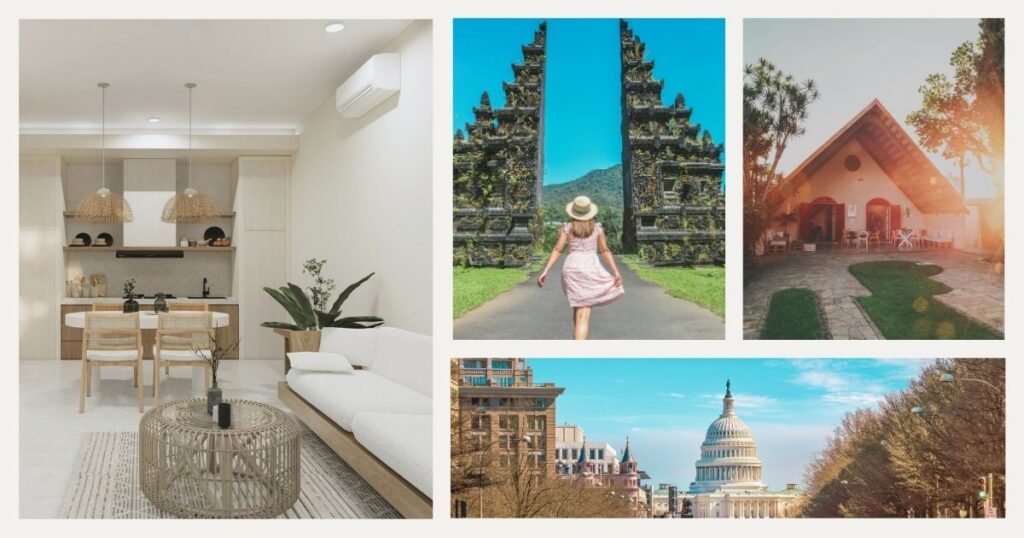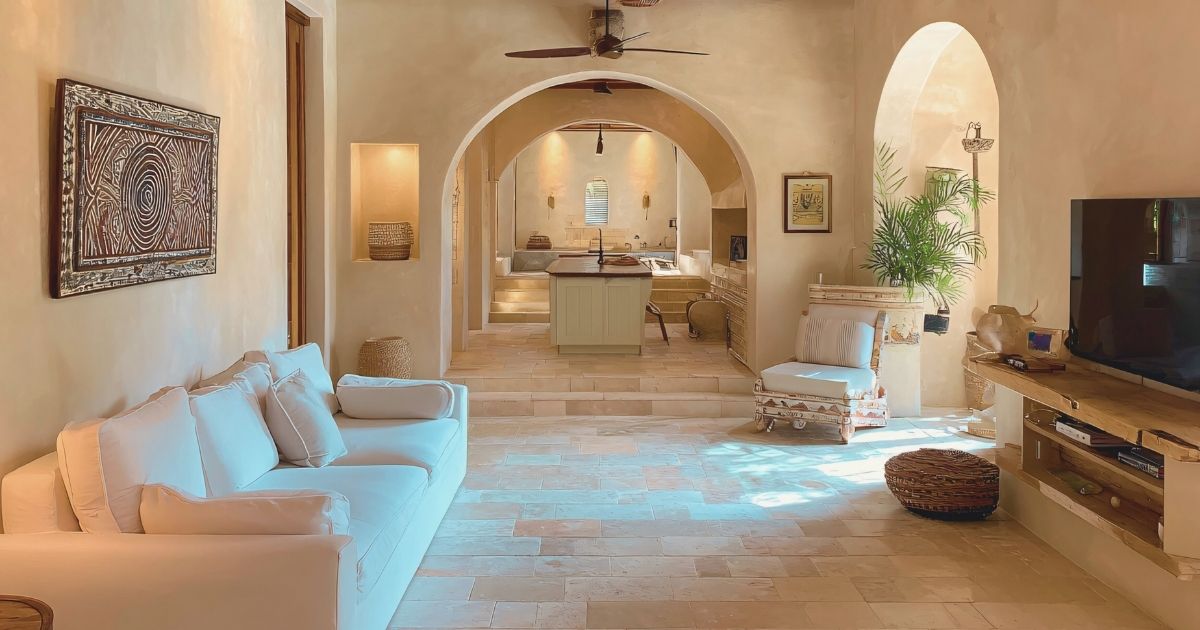The dramatic difference in the cost of living in Bali vs the US has made Indonesia’s tropical paradise one of the world’s most attractive destinations for American digital nomads, retirees, and remote workers seeking financial freedom without sacrificing quality of life. While a modest apartment in San Francisco might cost $3,000 monthly, a luxury villa with a pool in Bali could cost half that amount.
Understanding these cost differentials goes beyond simple price comparisons to examine purchasing power, lifestyle quality, and hidden expenses that impact your real financial picture. From healthcare and transportation to dining and entertainment, every aspect of daily life presents significant savings opportunities for Americans willing to embrace tropical living.
This comprehensive analysis reveals the true financial impact of relocating from the United States to Bali, helping you make informed decisions about international relocation, extended stays, or digital nomad adventures that could dramatically transform your financial trajectory.
Housing and accommodation comparison

Housing represents the most dramatic difference when comparing the cost of living in Bali vs the US, with potential savings of 60-80% for equivalent comfort levels and amenities.
💡 Did you know? A luxury villa with private pool, garden, and full-time staff in Bali often costs less than a basic studio apartment in major US cities like New York, San Francisco, or Los Angeles. This dramatic difference in housing costs is the primary driver behind American expatriates’ financial freedom in Indonesia.
US housing market reality
The average rent for a one-bedroom apartment in major US cities ranges from $1,500-4,000 monthly, with premium locations like Manhattan and San Francisco commanding $4,000-8,000+ for modest accommodations.
Even smaller US cities typically charge $800-1,500 monthly for basic apartments, while suburban homes require $2,000-5,000 monthly. Utilities average $150-300 monthly for electricity, water, heating, and internet services.
Bali housing opportunities
Modern one-bedroom apartments in popular Bali areas cost $400-800 monthly, featuring contemporary amenities, swimming pools, and tropical gardens. These properties often include utilities and maintenance services.
Luxury villas with 2-4 bedrooms, private pools, and staff services range from $800-2,000 monthly, providing resort-style living at prices comparable to basic US apartments. Budget accommodations start around $200-400 monthly for private rooms or studios.
🌟 Pro tip: ensure seamless property searching and communication with landlords using global connectivity services that provide reliable internet access for virtual tours, contract negotiations, and ongoing property management coordination.
Food and dining cost analysis
Food expenses reveal another significant advantage in the cost of living in Bali vs the US, with local dining options providing exceptional value while international cuisine remains reasonably priced.
US food and restaurant costs
Average restaurant meals in the US cost $15-25 for casual dining, $30-60 for mid-range establishments, and $75-150+ for fine dining. Fast food meals average $8-12, while coffee shop visits cost $4-6 per drink.
Grocery shopping typically requires $300-600 monthly for individuals, with organic and specialty items commanding premium prices. Food delivery services add convenience fees and tips that can double meal costs.
Bali dining value proposition
Traditional warungs serve authentic Indonesian meals for $1-3, providing generous portions of rice, vegetables, and protein. International restaurants charge $5-15 for main courses, dramatically less than US equivalents, while maintaining quality.
Grocery shopping at local markets costs $50-100 monthly for fresh produce and basic ingredients, while international supermarkets charge $100-200 monthly for Western brands.
The cost of living in Bali vs the US creates opportunities for Americans to dine out regularly while spending less than home cooking costs in major US cities.
Transportation cost differences

Transportation expenses showcase dramatic savings potential, with Bali’s scooter-based culture contrasting sharply with US car dependency and associated costs.
US transportation expenses
Car ownership involves monthly payments ($300-800), insurance ($100-300), fuel ($150-400), maintenance ($100-200), and parking fees ($50-500 monthly in urban areas).
Public transportation costs $80-200 monthly for unlimited passes, while ride-sharing services charge $15-40 per trip. Domestic flights typically cost $200-600 for occasional travel.
Bali transportation solutions
Scooter rentals cost $40-80 monthly including insurance, providing complete independence. Daily fuel costs range from $2-4, making scooters exceptionally economical.
Ojek (motorcycle taxis) charge $1-3 for local trips, while ride-sharing apps offer journeys at $3-8 within popular areas. Car rentals for special occasions cost $20-40 daily.
The cost of living in Bali vs the US creates transportation savings of 70-90% while often providing greater convenience for daily travel needs.
Healthcare and medical services
Healthcare costs represent another significant advantage for Americans considering Bali relocation, with quality medical care available at substantially reduced prices.
US healthcare reality
US health insurance premiums average $400-800 monthly for individuals, with family plans often exceeding $1,500 monthly. Medical consultations cost $200-500 without insurance, while specialist visits range from $300-800.
Emergency room visits can generate bills of $1,000-10,000+ depending on treatment complexity. Prescription medications and dental care carry substantial costs even with insurance coverage.
Bali healthcare value
Private medical consultations cost $20-60 at international-standard clinics with English-speaking doctors. Dental services offer exceptional value with routine cleanings costing $15-30 and major procedures available at 50-70% savings.
Comprehensive travel health insurance costs $200-600 annually, providing emergency coverage at prices lower than single US medical consultations. Many Americans find cash payments in Bali cost less than their US insurance deductibles.
Lifestyle and entertainment costs

Recreation and entertainment expenses further demonstrate the financial advantages when comparing the cost of living in Bali vs the US.
US entertainment expenses
US entertainment includes movie tickets ($12-20), concert events ($50-300+), fitness memberships ($50-150 monthly), and dining entertainment exceeding $100-200 per evening.
US nightlife involves substantial costs for drinks ($8-15 each), cover charges ($20-50), and transportation to entertainment districts.
Bali lifestyle value
Fitness activities include yoga classes ($8-15), gym memberships ($30-80 monthly), and free beach workouts or volcano hiking. Cultural activities like temple visits cost $1-3 in entrance fees.
Beach clubs offer drinks at $3-8 each, with many venues providing stunning ocean views and resort-style amenities. The cost of living in Bali vs the US enables Americans to maintain active lifestyles while spending significantly less.
Professional and work-related expenses
Remote work expenses reveal additional savings opportunities for digital nomads and entrepreneurs when comparing costs between locations.
US professional costs
Co-working spaces charge $200-600 monthly for dedicated desks, while private offices cost $1,000-3,000+ monthly. Professional services involve hourly rates of $150-500+ in major markets.
Bali professional environment
Co-working spaces charge $50-150 monthly for full access, including high-speed internet, meeting rooms, and networking events. Professional services remain affordable at 50-70% savings compared to US rates.
The cost of living in Bali vs the US allows Americans to invest more in business development due to reduced living expenses.
Sample budget comparisons
Real-world budget examples illustrate the practical implications of cost differences between locations.
Budget lifestyle comparison
US budget living: $2,500-3,500 monthly
- Shared housing: $800-1,200
- Food/groceries: $400-600
- Transportation: $200-400
- Healthcare: $300-500
- Utilities: $150-250
- Entertainment: $200-400
Bali budget living: $800-1,200 monthly
- Private accommodation: $250-400
- Mixed dining: $150-250
- Transportation: $60-100
- Health insurance: $50-100
- Utilities: $60-100
- Entertainment: $100-200
Comfortable lifestyle comparison
US comfortable living: $4,500-6,500 monthly
- One-bedroom apartment: $1,500-2,500
- Quality dining: $600-900
- Car ownership: $500-800
- Health insurance: $400-600
- Full utilities: $250-400
- Entertainment: $500-800
Bali comfortable living: $1,500-2,200 monthly
- Modern villa: $600-900
- International dining: $300-450
- Transportation: $100-150
- Insurance: $100-150
- Utilities: $100-150
- Activities: $250-400
The cost of living in Bali vs the US demonstrates potential savings of 60-75% across all lifestyle levels while often improving quality of life through tropical climate and cultural richness.
Hidden costs and considerations

Understanding the complete financial picture requires examining hidden costs and lifestyle adjustments that impact the true cost comparison.
US hidden expenses
US living involves property taxes, insurance, HOA fees, and maintenance expenses adding $500-2,000+ monthly to housing. Healthcare deductibles and insurance gaps create unpredictable medical expenses.
Bali additional considerations
Visa costs, international health insurance, and periodic visa runs add $500-1,500 annually. Import duties on electronics and specialty foods can increase costs for imported goods, though local alternatives often provide adequate substitutes.
Currency fluctuation risks can impact long-term financial planning for Americans earning dollars while spending rupiah. The cost of living in Bali vs the US generally favors Indonesia even after accounting for these considerations.
Final thoughts
The cost of living in Bali vs the US reveals dramatic savings opportunities that can transform financial trajectories for Americans willing to embrace international living. With potential savings of 60-80% across major expense categories, many Americans discover they can live more comfortably in Bali while spending less than basic survival costs in major US cities.
However, successful international relocation requires careful planning, cultural adaptation, and realistic expectations about infrastructure differences. The financial advantages are clear, but personal suitability varies based on career requirements, family situations, and preferences for familiar environments versus cultural adventure.
Ready to explore your options for international living? Understanding cost differences is just the beginning of planning your global lifestyle. For insights into other destinations worldwide, check our guide to the most expensive countries to live in to understand the full spectrum of international living costs.
Let Nomada guide you toward financial freedom through smart location choices 🌴
Frequently asked questions about the cost of living in Bali vs the US
The cost of living in Bali vs the US typically offers 60-80% savings across major expense categories. Americans spending $4,000-6,000 monthly in the US can often maintain similar or better lifestyles in Bali for $1,500-2,500 monthly, with savings particularly dramatic in housing, food, and transportation costs where reductions of 70-90% are common.
Housing shows the most dramatic differences, with luxury Bali villas costing less than basic US apartments. Transportation savings of 70-90% come from scooter culture versus car dependency, while healthcare costs 80-90% less in Bali. Food expenses can be 60-80% lower when embracing local dining options alongside international cuisine.
Imported goods, electronics, and specialty Western foods often cost more in Bali due to import duties and shipping costs. International health insurance and visa expenses add costs not present in home country living, though these typically remain minimal compared to overall savings achieved through strategic lifestyle choices.
Quality of life comparisons depend on individual priorities and circumstances. Bali offers a tropical climate, reduced financial stress, cultural richness, and a strong community atmosphere, while the US provides infrastructure reliability, familiar systems, and extensive career opportunities. Many Americans find Bali’s lifestyle benefits outweigh infrastructure limitations, particularly for remote workers and retirees.
Hidden costs include visa fees and renewals ($500-1,500 annually), international health insurance, periodic visa runs, import duties on personal items, and currency exchange fees. While these add expenses not present in US living, they typically remain small compared to the overall cost savings achieved through relocation to Indonesia.
For most Americans with location independence, the cost of living in Bali vs the US creates substantial financial advantages. Potential annual savings of $20,000-50,000+ make relocation financially attractive, particularly for remote workers, retirees, or entrepreneurs. Personal circumstances, career requirements, and lifestyle preferences should guide individual decisions about international moves.




